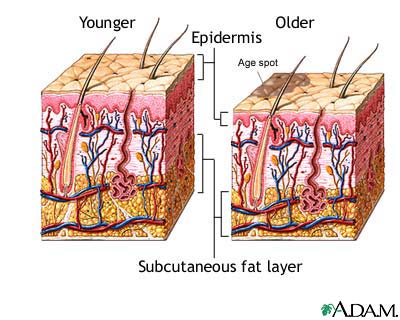Aging, integumentary changes that occur with

Though the premise of aging tends to conjure images of WRINKLES and gray HAIR or baldness, the SKIN, hair, and NAILS undergo numerous changes across the lifespan.
Integumentary Changes in Youth
During infancy and early childhood, the integumentary structures are soft and the hair may be fine. By about age 10 or 11 years, the hormonal shifts of PUBERTY are under way. Isolated pimples may break out on the face, chest, and back. Hair patterns begin to change as the sex hormones stimulate SECONDARY SEXUAL CHARACTERISTICS such as axillary (underarm) and pubic hair growth. Within a few years the hair on the legs thickens and darkens, and boys begin to sprout facial hair. The sebaceous structures kick up sebum production, and the dermis accelerates cell production to accommodate new skin to cover what can amount to several inches of new height each year. ACNE, an inflammatory process involving the sebaceous structures, is the most common skin condition that occurs between the ages of 14 and 22.
The skin, hair, and nails outwardly remain relatively stable during young adulthood, the third and fourth decades of life, though are collecting the cumulative effects of factors such as sun exposure, scarring, and other evidence of life experience. People who work outdoors or participate in outdoor activities begin to show these effects earlier than their counterparts who limit their exposure the natural elements. Repeated sun exposure may result in tanning, a look that may be fashionably desirable though also causes LENTIGINES (freckles and “age” spots), roughness, and wrinkles. The hands may develop calluses and the feet CORNS.
Integumentary Changes in Midlife
At about age 40 the connective tissues throughout the body begin to gradually lose elasticity, allowing the skin to sag and form more wrinkles. Dermatologists call this loss elastosis. As well, the epidermis (outer layer of the skin) and the adipose tissue (fat) beneath the skin both thin. The epidermis becomes more fragile and susceptible to punctures and tears. Though losing a little fat under the skin might sound like a benefit when other areas of the body are demonstrating an age-related propensity to accumulate fat, the diminished integumentary adipose tissue reduces the skin’s ability to regulate heat loss and retention. The older people get, the greater their tendency to feel cold even when the external environment is warm. The risk for heat and cold injuries affecting the skin, such as sunburn and frostbite, also increases.
By midlife even the skin of those who are not the outdoors types usually has weathered significant exposure to sun, wind, and chemicals that can cause trauma and damage. ACTINIC KERATOSIS, a condition of precancerous growths on sunexposed skin, and SKIN CANCER such as basal cell carcinoma or squamous cell carcinoma, may manifest, arising from skin damage that occurred decades earlier. Sunscreen, the mainstay of SUN PROTECTION for children today, had not yet been developed during the childhoods of those who are today over age 30.
Age-related changes begin to affect the hair in midlife, too. Melanocytes, skin cells that produce melanin, thin from the hair follicles, diminishing the amount of pigment that appears in new hair fibers. Reduced pigment produces hair that appears gray; complete absence of pigment produces white hair. These changes occur regardless of the hair’s natural hair color. Men and women both experience patterned ALOPECIA (hair loss), though in men the loss of hair is generally more pronounced.
Integumentary Changes in Late Life
By the seventh, eighth, and ninth decades of life, the epidermis becomes so thin as to reveal the coloration of the tissues that lie beneath the skin. The skin drapes loosely over the body, tearing and bruising easily. Blood vessels ridge beneath the skin like pipe cleaners under wet tissue paper, trailing along the backs of the hands and arms and on the lower legs and feet. Threadlike networks of capillaries etch across the cheeks. Late in life, the skin continues to do a remarkable job protecting the body, yet is especially vulnerable to damage.
Maintaining Healthy Skin Across the Lifespan
Anti-aging remedies abound, and some-such as those that add moisture and vitamins to the skin—help the skin remain supple and smooth longer in life than without their use. But the most effective anti-aging approach is to take good care of the skin all through life, beginning in childhood. Appropriate nutrition, protection from the sun and other elements of weather, and good hygiene are simple, yet effective, measures to keep the skin healthy throughout life.
See also CALLUS; FITZPATRICK SKIN TYPE; MELANOCYTE; SCAR.